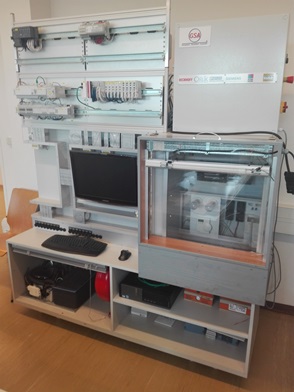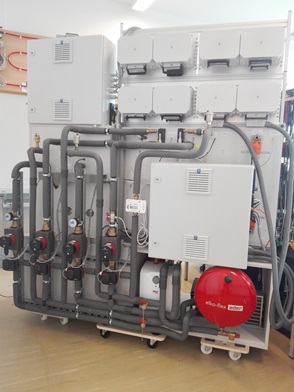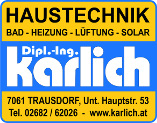|
The HVAC (heating, ventilation, air conditioning) model plant was designed to emulate the physical environment of an HVAC system and to supply a test chamber with conditioned air. It provides all major sensing and actuating components a real-life HVAC system of a modern building is constituted of, like temperature and humidity sensors, fans, flaps as well as pumps and valves in the hydraulic plant. The test chamber is also equipped with components to monitor and additionally influence the thermal conditions inside. This allows a realistic modelling and testing of the air conditioning process. The physical states of the built-in field devices, i.e., the sensors and actuators, are represented by electrical signals (standard analogue 0…10V, PT1000, 24VDC signals) which are collected at unified terminals. These terminals acts as an interface via which various controllers (DDCs – direct digital control or PLCs – programmable logic controllers) can be connected to the field devices either directly or by means of building automation networks (e.g. BACnet, LoNWorks, KNX). Currently, seven different controllers of mostly different manufacturers are available:
|
 |
| On these controllers, applications for various purposes can be implemented like for performing control tasks. By such a control application, measured sensor values are processed, user inputs (setpoints) are considered and output values are calculated and fed back to the actuators.
The HVAC model plant finds use in versatile purposes. During the course “Home and Building Automation” it acts as a platform for students to gain first practical experiences in automation system engineering / programming and learning about the influences on the underlying physics of an HVAC system. Also when it comes to evaluation phases in our research projects, it acts as a test bed for prototypes and proof-of-concepts. In 2016, major parts of the plant where redesigned and refurbished. The hydraulic installation was built up using state-of-the-art components for pumps and mixing valves. Also the electrical wiring was renewed including the unified plug system for connecting controllers. This refurbishment was carried out by a number of highly professional companies which contributed to the project in a very generous way. We hereby express our special thanks to all our supporters:
|
 |
 |
 |
 |
|
| |
 |
|
|

